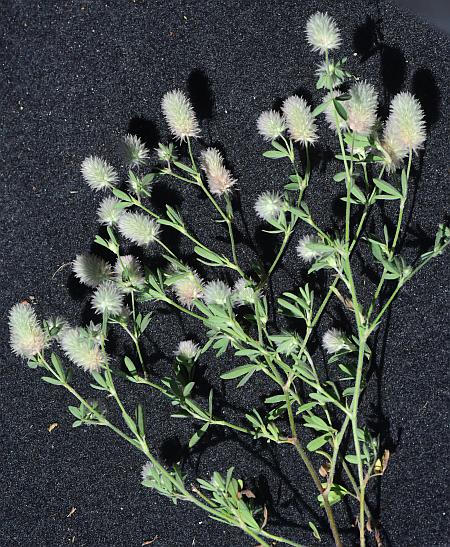Trifolium arvense L.
Rabbit's Foot Clover

Introduced
CC = *
CW = 5
MOC = 19
© SRTurner
Trifolium arvense L.Rabbit's Foot Clover | |
 |
Introduced CC = * CW = 5 MOC = 19 |
© SRTurner |
|
Family - Fabaceae/Faboideae Habit - Taprooted annual forb. Stems - Weakly ascending to erect, to 40 cm, not rooting at the nodes, often much-branched, with dense, appressed to spreading, silky hairs.
Leaves - Alternate, trifoliate, petiolate, stipulate. Petioles to 15 mm on lower leaves, very short on upper leaves, shorter than the leaflets. Stipules longer than the associated petiole, narrowly lanceolate, the fused basal portion short and broad, the elongate free portions narrowly long-tapered at the tips, membranous between the veins, the margins usually entire. Leaflets 5-20 mm long, 2-4 mm wide, all sessile or nearly so, linear to narrowly lanceolate, angled at the base, angled or abruptly short-tapered to a sharply pointed tip, the margins with relatively few, minute, very inconspicuous, blunt teeth, the surfaces finely pubescent with long appressed to loosely appressed hairs.
Inflorescences - Dense, ovoid to cylindric spikes, 8-30 mm long (usually elongating with age), 8-10 mm wide, the stalk 5-30 mm long. Flowers 10-150, sessile, spreading in various directions at fruiting.
Flowers - Calyces 4-7 mm long, the tube 1.5-2.0 mm long, long-hairy, often silvery to pinkish-or purplish-tinged, the teeth 1.5-2.0 times as long as the tube, equal or subequal, slender and longtapered, plumose, lacking a prominent network of nerves and not becoming inflated at fruiting. Corollas 3-4 mm long, shorter than the calyx lobes, pale pink (white elsewhere), the banner outcurved, narrowly oblong, rounded to bluntly and broadly angled at the tip, faintly to moderately nerved, especially with age.
Fruits - Legumes, enclosed by persistent calyx, 1.2-1.5 mm long, ovoid, sessile, the outer wall membranous to papery, 1-seeded. Seeds 0.9-1.3 mm long, more or less globose, pale yellow to pale yellowish green, shiny. Flowering - May - October. Habitat - Pastures, fields, roadsides, railroads, open disturbed areas. Origin - Native to Europe. Introduced into many parts of the world. Lookalikes - None. Other info. - This weedy introduced species can be found in scattered counties in Missouri, predominantly in the southwestern region. It occurs throughout much of the continental U.S. but is absent from several central-southwestern states. The plant is very easy to ID in the field because of its short, fuzzy inflorescences and widely branching habit. The flowers are typically pale pink but a white-flowered form can also be found. The plant is sometimes is cultivated as a winter annual, and is adapted to infertile, dry, often sandy soil. Its presence on roadsides makes an attractive, silvery-pink display during flowering, turning rose to buff when in fruit. Other colloquial names include hare's foot, stone clover, old-field clover, and pussies. Photographs taken in Vale, NC., 5-11-03 (DETenaglia); also near Miner, Scott County, MO, 5-29-2020 (SRTurner). |